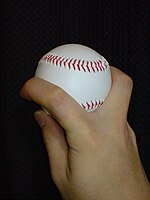| This article needs additional citations for verification. (July 2007) |
The forkball is a type of pitch in baseball. Related to the split-finger fastball, the forkball is held between the first two fingers and thrown hard snapping the wrist.
The forkball differs from the split-fingered fastball, however, in that the ball is jammed deeper between the first two fingers. The result is that the forkball is generally thrown slightly slower than the splitter, but will have more of a “tumbling” action akin to the movement of a 12–6 curveball, as it will drop off the plate before it gets to the catchers mitt.
Contents
Use in the Major Leagues[edit]
The forkball has been favored by several current and former major league pitchers, including Hideo Nomo, José Valverde, José Arredondo, Kazuhiro Sasaki, José Contreras, Chien-Ming Wang and Edwar Ramírez. Two-time Cy Young Award winner Tim Lincecum uses a changeup with forkball movement as his strike-out pitch. In addition, a number of NPB players throw forkballs, including Kazumi Saito of the Fukuoka SoftBank Hawks who has ridden his forkball to two Eiji Sawamura Awards. In actuality, the forkball is more popular than the splitter in Japan, and the vast majority of the best pitchers in Japan have one in their arsenal.[citation needed] Former Major League pitchers Dave Stewart and Mélido Pérez were two of the most highly regarded forkball pitchers in the late 1980s. Late in his career, the forkball was also used by Sandy Koufax. Jack Morris used a forkball as his primary strikeout pitch while winning more games than any other pitcher in the 1980s. Roy Face and Lindy McDaniel were relief pitchers who pitched for 21 years in the Major Leagues and were forkballers. Face started his career in 1949 and McDaniel in 1955.
Throwing mechanics[edit]
The forkball is thrown with the same arm speed of a fastball, but at release point, the wrist is snapped downward. Additionally, allowing the ball to spin off the middle or index finger may result in additional movement. [1]
Origin of the forkball[edit]
“Bullet” Joe Bush of the Boston Red Sox is credited with the invention of the forkball, shortly following World War I.[2] However, it was popularized by former relief pitcher Roy Face of the Pittsburgh Pirates.
Medical concerns[edit]
The forkball, if thrown correctly, is known to be a cause of significant and increasingly common damage to the shoulder and elbow. Famous forkballers, particularly Japanese players, have often required surgery to remove bone fractures or to repair damaged tendons, sometimes several times in their careers. Younger players are discouraged from attempting to throw the forkball before reaching the age of 17-18.[citation needed] One such pitcher was former Yokohama BayStars and Seattle Mariners closer Kazuhiro Sasaki.[citation needed] However, these injuries are avoidable; if the pitcher does not snap his wrist in the motion, then the forkball theoretically should have no damaging effect to his arm. The only trade off is a slight decrease in speed; the pitch should still break the same way.
Notes[edit]
- ^ Gotch, Nathan. “How to Throw a Forkball?”. The Ultimate Pitcher. Retrieved 14 August 2013.
- ^ Wood, Allan (2000). Babe Ruth and the 1918 Red Sox. San Jose ola: Writers Club Press. p. 372. ISBN 0-595-14826-3.
|
|||||||||||||||||
This article uses material from the Wikipedia article Forkball, which is released under the Creative Commons Attribution-Share-Alike License 3.0.









